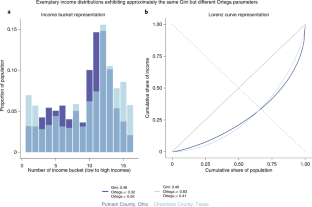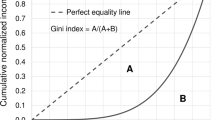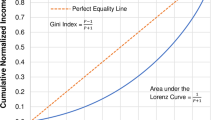Abstract
Prior research has found mixed results on how economic inequality is related to various outcomes. These contradicting findings may in part stem from a predominant focus on the Gini coefficient, which only narrowly captures inequality. Here, we conceptualize the measurement of inequality as a data reduction task of income distributions. Using a uniquely fine-grained dataset of N = 3,056 US county-level income distributions, we estimate the fit of 17 previously proposed models and find that multi-parameter models consistently outperform single-parameter models (i.e., models that represent single-parameter measures like the Gini coefficient). Subsequent simulations reveal that the best-fitting model—the two-parameter Ortega model—distinguishes between inequality concentrated at lower- versus top-income percentiles. When applied to 100 policy outcomes from a range of fields (including health, crime and social mobility), the two Ortega parameters frequently provide directionally and magnitudinally different correlations than the Gini coefficient. Our findings highlight the importance of multi-parameter models and data-driven methods to study inequality.
This is a preview of subscription content, access via your institution
Access options
Access Nature and 54 other Nature Portfolio journals
Get Nature+, our best-value online-access subscription
$29.99 / 30 days
cancel any time
Subscribe to this journal
Receive 12 digital issues and online access to articles
$119.00 per year
only $9.92 per issue
Buy this article
- Purchase on Springer Link
- Instant access to full article PDF
Prices may be subject to local taxes which are calculated during checkout





Similar content being viewed by others
Data availability
All data to reproduce the findings discussed in this paper are available at http://www.measuringinequality.com/.
Code availability
All code to reproduce the findings discussed in this paper are available at http://www.measuringinequality.com/.
References
Davies, J., Lluberas, R. & Shorrocks, A. in Credit Suisse Wealth Report 1–157 (Credit Suisse, 2016); https://www.credit-suisse.com/media/assets/corporate/docs/about-us/research/publications/global-wealth-databook-2016.pdf
Cornia, G. A. Falling Inequality in Latin America: Policy Changes and Lessons (Oxford Univ. Press, 2014).
Wilkinson, R. & Pickett, K. The Spirit Level: Why Greater Equality Makes Societies Stronger (Bloomsbury, 2011).
Pickett, K. E., Kelly, S., Brunner, E., Lobstein, T. & Wilkinson, R. G. Wider income gaps, wider waistbands? An ecological study of obesity and income inequality. J. Epidemiol. Community Health 59, 670–674 (2005).
Kim, D., Wang, F. & Arcan, C. Geographic association between income inequality and obesity among adults in New York State. Prev. Chronic Dis. 15, E123 (2018).
Ngamaba, K., Panagioti, M. & Armitage, C. Income inequality and subjective well-being: a systematic review and meta-analysis. Qual. Life Res. 27, 577–596 (2018).
Côté, S., House, J. & Willer, R. High economic inequality leads higher-income individuals to be less generous. Proc. Natl Acad. Sci. USA 112, 15838–15843 (2015).
Schmukle, S. C., Korndörfer, M. & Egloff, B. No evidence that economic inequality moderates the effect of income on generosity. Proc. Natl Acad. Sci. USA 116, 9790–9795 (2019).
De Maio, F. Income inequality measures. J. Epidemiol. Community Health 61, 849–852 (2007).
Tackling High Inequalities Creating Opportunities for All (OECD, 2014); https://www.oecd.org/unitedstates/Tackling-high-inequalities.pdf
Hearing document: Congress must act to reduce inequality for working families. In Hearing before the Committee on the Budget House of Representatives Congress Hearing No. 116-14 (116th Congress, 2019); https://budget.house.gov/sites/democrats.budget.house.gov/files/documents/Inequality%20Post%20Hearing%20Report_Final.pdf
Charles-Coll, J. Understanding income inequality: concept, causes and measurement. Int. J. Econ. Manage. Sci. 1, 17–28 (2011).
Giorgi, G. & Gigliarano, C. The Gini concentration index: a review of the inference literature. J. Econ. Surv. 31, 1130–1148 (2016).
Sitthiyot, T. & Holasut, K. A simple method for measuring inequality. Palgrave Commun. 6, 112 (2020).
Gini Index (World Bank, 2021); https://data.worldbank.org/indicator/SI.POV.GINI
Cowell, F. in Handbook of Income Distribution (eds Atkinson, A. & Bourguignon, F.), Ch. 2 (Elsevier, 2000).
Liu, Y. & Gastwirth, J. L. On the capacity of the Gini index to represent income distributions. METRON 78, 61–69 (2020).
Fellman, J. Income inequality measures. Theor. Econ. Lett. 08, 557–574 (2018).
Clementi, F., Gallegati, M., Gianmoena, L., Landini, S. & Stiglitz, J. Mis-measurement of inequality: a critical reflection and new insights. J. Econ. Interact. Coord. 14, 891–921 (2019).
Atkinson, A. & Bourguignon, F. Handbook of Income Distribution 1st edn, Vol. 1 (Elsevier, 2000); https://EconPapers.repec.org/RePEc:eee:income:1
Davies, J., Hoy, M. & Zhao, L. Revisiting comparisons of income inequality when Lorenz curves intersect. Soc. Choice Welfare 58, 101–109 (2022).
Davydov, Y. & Greselin, F. Comparisons between poorest and richest to measure inequality. Sociol. Methods Res. 49, 526–561 (2020).
Atkinson, A. B. On the measurement of inequality. J. Econ. Theory 2, 244–263 (1970).
Zanardi, G. Della asimmetria condizionata delle curve di concentrazione. lo scentramento. Riv. Ital. Econ. Demogr. Stat. 18, 431–466 (1964).
Gwatkin, D. Health inequalities and the health of the poor: what do we know? What can we do? Bull. World Health Organ. 78, 3–18 (2000).
Ortega, P., Martín, G., Fernández, A., Ladoux, M. & García, A. A new functional form for estimating Lorenz curves. Rev. Income Wealth 37, 447–452 (1991).
De Dominicis, L., Florax, R. J. & De Groot, H. L. A meta-analysis on the relationship between income inequality and economic growth. Scott. J. Polit. Econ. 55, 654–682 (2008).
Kondo, N. et al. Income inequality, mortality, and self rated health: meta-analysis of multilevel studies. Br. Med. J. 339, 1178–1181 (2009).
American Community Survey, 2011–2015: 5-Year Period Estimates (US Census Bureau, 2016); https://data2.nhgis.org/main
Chetty, R. et al. The association between income and life expectancy in the United States, 2001–2014. JAMA 315, 1750–1766 (2016).
Chetty, R. & Hendren, N. The impacts of neighborhoods on intergenerational mobility II: county-level estimates. Q. J. Econ. 133, 1163–1228 (2018).
Abdi, H. Bonferroni and Šidák corrections for multiple comparisons. Encycl. Meas. Stat. 3, 103–107 (2007).
Abdullah, A., Doucouliagos, H. & Manning, E. Does education reduce income inequality? A meta-regression analysis. J. Econ. Surv. 29, 301–316 (2015).
Hauser, O. P. & Norton, M. I. (Mis)perceptions of inequality. Curr. Opin. Psychol. 18, 21–25 (2017).
Knell, M. & Stix, H. Perceptions of inequality. Eur. J. Polit. Econ. 65, S0176268020300756 (2020).
Phillips, L. T. et al. Inequality in people’s minds. Preprint at PsyArXiv https://doi.org/10.31234/osf.io/vawh9 (2020).
Jachimowicz, J. M. et al. Inequality in researchers’ minds: four guiding questions for studying subjective perceptions of economic inequality. J. Econ. Surv. https://doi.org/10.1111/joes.12507 (2022).
Most Americans Say There Is Too Much Economic Inequality in the U.S., but Fewer Than Half Call It a Top Priority (Pew Research Center, 2020); https://www.pewresearch.org/social-trends/wp-content/uploads/sites/3/2020/01/PSDT_01.09.20_economic-inequailty_FULL.pdf
Brown-Iannuzzi, J. L., Lundberg, K. B. & McKee, S. E. Economic inequality and socioeconomic ranking inform attitudes toward redistribution. J. Exp. Soc. Psychol. 96, 104180 (2021).
Income Share Held by Highest 20% (World Bank, 2021); https://data.worldbank.org/indicator/SI.DST.05TH.20
Cowell, F. Measuring Inequality 3rd edn (Oxford Univ. Press, 2011); https://EconPapers.repec.org/RePEc:oxp:obooks:9780199594047
Campano, F. & Salvatore, D. Income Distribution (Oxford Univ. Press, 2006); https://EconPapers.repec.org/RePEc:oxp:obooks:9780195300918
Slottje, D. J. Using grouped data for constructing inequality indices: parametric vs. non-parametric methods. Econ. Lett. 32, 193–197 (1990).
Jorda, V., Sarabia, J. M. & Jäntti, M. Inequality measurement with grouped data: parametric and non-parametric methods. J. R. Stat. Soc. Ser. A 184, 964–984 (2021).
Gastwirth, J. L. A general definition of the Lorenz curve. Econometrica 39, 1037–1039 (1971).
Krause, M. Parametric Lorenz curves and the modality of the income density function. Rev. Income Wealth 60, 905–929 (2014).
Basmann, R., Hayes, K., Slottje, D. & Johnson, J. A general functional form for approximating the Lorenz curve. J. Econ. 43, 77–90 (1990).
Kakwani, N. On a class of poverty measures. Econometrica 48, 437–446 (1980).
Krause, M. Parametric Lorenz curves and the modality of the income density function. Rev. Income Wealth 60, 905–929 (2014).
Chotikapanich, D. & Griffiths, W. E. Estimating Lorenz curves using a Dirichlet distribution. J. Bus. Econ. Stat. 20, 290–295 (2002).
Paul, S. & Shankar, S. An alternative single parameter functional form for Lorenz curve. Empir. Econ. 59, 1393–1402 (2020).
Sommeiller, E., Price, M. & Wazeter, E. Income Inequality in the US by State, Metropolitan Area, and County Tech. Rep. (EPI, 2016); https://www.epi.org/publication/income-inequality-in-the-us/#epi-toc-1
Sugiura, N. Further analysts of the data by Akaike’ s information criterion and the finite corrections. Commun. Stat. Theory Methods 7, 13–26 (1978).
Hurvich, C. M. & Tsai, C.-L. Regression and time series model selection in small samples. Biometrika 76, 297–307 (1989).
Akaike, H. A new look at the statistical model identification. IEEE Trans. Autom. Control 19, 716–723 (1974).
Brams, S. J. & Fishburn, P. C. in Handbook of Social Choice and Welfare Vol. 1 (eds Arrow, K. J. et al.) 173–236 (Elsevier, 2002); http://www.sciencedirect.com/science/article/pii/S157401100280008X
Burnham, K. P. & Anderson, D. R. Multimodel inference: understanding AIC and BIC in model selection. Sociol. Methods Res. 33, 261–304 (2004).
Sarabia, J. M., Castillo, E. & Slottje, D. An ordered family of Lorenz curves. J. Econ. 91, 43–60 (1999).
Benhabib, J. & Bisin, A. Skewed wealth distributions: theory and empirics. J. Econ. Lit. 56, 1261–1291 (2018).
Jenkins, S. P. Pareto models, top incomes and recent trends in UK income inequality. Economica 84, 261–289 (2017).
Arnold, B. C. Pareto Distribution (American Cancer Society, 2015); https://doi.org/10.1002/9781118445112.stat01100.pub2
Kakwani, N. C. & Podder, N. On the estimation of Lorenz curves from grouped observations. Int. Econ. Rev. 14, 278–292 (1973).
Rasche, R. H., Gaffney, J., Koo, A. Y. C. & Obst, N. Functional forms for estimating the Lorenz curve. Econometrica 48, 1061–1062 (1980).
Chotikapanich, D. A comparison of alternative functional forms for the Lorenz curve. Econ. Lett. 41, 129–138 (1993).
Abdalla, I. M. & Hassan, M. Y. Maximum likelihood estimation of Lorenz curves using alternative parametric model. Metodoloski Zv. 1, 109–118 (2004).
Rohde, N. An alternative functional form for estimating the Lorenz curve. Econ. Lett. 105, 61–63 (2009).
Wang, Z., Ng, Y.-K. & Smyth, R. A general method for creating Lorenz curves. Rev. Income Wealth 57, 561–582 (2011).
Arnold, B. C. & Sarabia, J. M. Majorization and the Lorenz Order with Applications in Applied Mathematics and Economics 1st edn (Springer International, 2018).
Kleiber, C. & Kotz, S. A characterization of income distributions in terms of generalized Gini coefficients. Soc. Choice Welfare 19, 789–794 (2002).
Dagum, C. Wealth distribution models: analysis and applications. Statistica 3, 235–268 (2006).
McDonald, J. Some generalized functions for the size distribution of income. Econometrica 52, 647–663 (1984).
Acknowledgements
We thank S. Bhatia, S. Davidai, T. Graeber and J. Tan for helpful discussions and comments that substantially improved this paper; I. Zahn for technical support; and M. Kalisch for his advice on statistics. We also acknowledge funding from the German Academic Scholarship Foundation (to K.B.), Harvard Business School (to J.M.J.), University of Exeter Business School (to O.P.H.) and the UKRI Future Leaders Fellowship (to O.P.H.). The funders had no role in study design, data collection and analysis, decision to publish or preparation of the manuscript.
Author information
Authors and Affiliations
Contributions
K.B. led the data collection and statistical analysis under the supervision of J.M.J. and O.P.H. All authors wrote and edited the paper.
Corresponding authors
Ethics declarations
Competing interests
The authors declare no competing interests.
Peer review
Peer review information
Nature Human Behaviour thanks the anonymous reviewers for their contribution to the peer review of this work.
Additional information
Publisher’s note Springer Nature remains neutral with regard to jurisdictional claims in published maps and institutional affiliations.
Supplementary information
Supplementary Information
Supplementary Figs. 1–24, Tables 1–11, Methods and Results.
Rights and permissions
Springer Nature or its licensor holds exclusive rights to this article under a publishing agreement with the author(s) or other rightsholder(s); author self-archiving of the accepted manuscript version of this article is solely governed by the terms of such publishing agreement and applicable law.
About this article
Cite this article
Blesch, K., Hauser, O.P. & Jachimowicz, J.M. Measuring inequality beyond the Gini coefficient may clarify conflicting findings. Nat Hum Behav 6, 1525–1536 (2022). https://doi.org/10.1038/s41562-022-01430-7
Received:
Accepted:
Published:
Issue Date:
DOI: https://doi.org/10.1038/s41562-022-01430-7
This article is cited by
-
Standard Deviation vs. Gini Coefficient: Effects of Different Indicators of Classroom Status Hierarchy on Bullying Behavior
Journal of Youth and Adolescence (2024)
-
A statistical examination of wealth inequality within the Forbes 400 richest families in the United States from 2000 to 2023
METRON (2024)
-
Subjective socioeconomic status and income inequality are associated with self-reported morality across 67 countries
Nature Communications (2023)
-
Perceptions of Income Inequality and Women’s Intrasexual Competition
Human Nature (2023)



